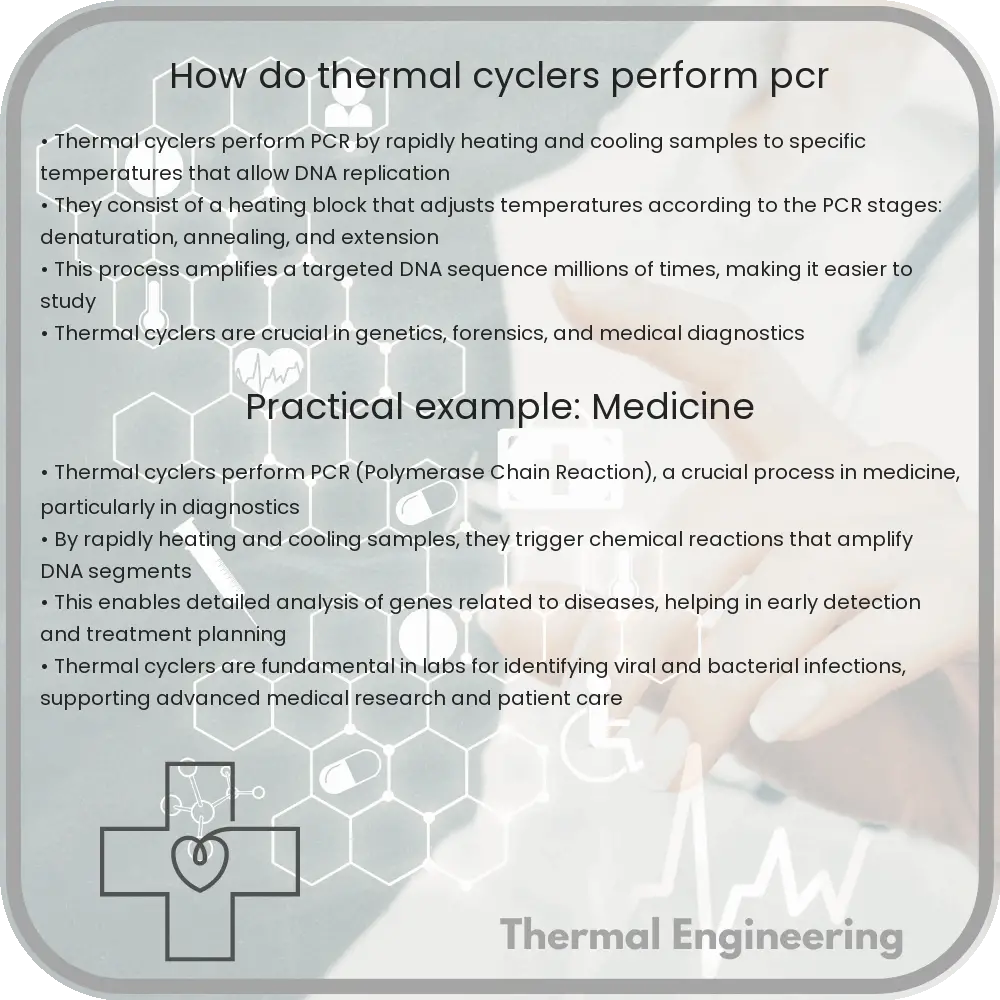Learn about thermal cyclers, vital devices for automating PCR by precisely controlling temperature changes to amplify DNA, essential in genetics and diagnostics.

Understanding the Role of Thermal Cyclers in Performing PCR
Polymerase Chain Reaction (PCR) is a pivotal technique in molecular biology that amplifies a specific segment of DNA, making millions of copies from a tiny sample. This process is crucial in genetic research, forensics, and medical diagnostics. Central to this method is a device known as a thermal cycler, which automates the temperature changes required during the PCR process.
Components and Functionality of a Thermal Cycler
A thermal cycler, also referred to as a PCR machine, primarily consists of a thermal block that can hold a number of tubes containing PCR mixtures, and a heating and cooling system that changes the temperature of the block according to the needs of the PCR protocol. Here’s how the thermal cycler functions through the main stages of PCR:
- Denaturation: During this initial stage, the thermal cycler heats the block to a high temperature (commonly around 94°C – 98°C). This heat causes the double-stranded DNA molecule to denature, or separate into two single strands, which prepares it for the next phase.
- Annealing: Following denaturation, the machine cools the block to a lower temperature (usually between 50°C to 65°C), allowing primers—short sequences of nucleotides that provide a starting point for DNA synthesis—to attach to the single-stranded DNA templates.
- Extension: The thermal cycler then raises the temperature again (typically to about 72°C) to activate the Taq polymerase enzyme, which starts synthesizing new DNA strands from the primers by adding nucleotides that are complementary to the template strands.
This cycle of temperature changes is repeated typically 25 to 35 times to amplify the target DNA sequence exponentially. Each cycle doubles the amount of DNA starting from the original template, theoretically doubling the DNA at every cycle if the efficiency is perfect.
Key Features of Thermal Cyclers
- Temperature Uniformity and Accuracy: To ensure the PCR runs effectively, the thermal cycler must maintain a uniform and precise temperature across the thermal block. This is crucial because even slight temperature variations can affect the efficiency and specificity of the PCR.
- Speed of Temperature Change: Rapid changes in temperature increase the throughput and decrease the total time required to complete PCR cycles. Modern thermal cyclers can change temperatures very quickly, thus reducing the overall duration of the PCR process.
- Programmable and User-friendly Interface: Thermal cyclers come with digital controls that allow scientists to program temperature profiles and the number of cycles. This automation makes the PCR process highly reproducible and less prone to human error.
- Heated Lid: To prevent condensation of the samples during high-temperature cycles, most thermal cyclers feature a heated lid. This lid prevents the formation of droplets on the top of the reaction tubes, which could otherwise lead to variations in reaction volumes and concentrations.
The Impact of Thermal Cyclers in Science and Medicine
The development of thermal cyclers has vastly improved the efficiency and accessibility of PCR. By automating the precise temperature changes required during the PCR, these machines have enabled widespread use of this method in various fields. From identifying genetic disorders and paternity testing to detecting pathogens and studying genetic sequences, the thermal cycler’s role in PCR is indispensable.
In conclusion, thermal cyclers have simplified the once time-consuming steps of PCR, bringing precision and reproducibility to molecular biology laboratories around the world. Their continuous evolution promises even greater enhancements in DNA analysis and molecular diagnostics.